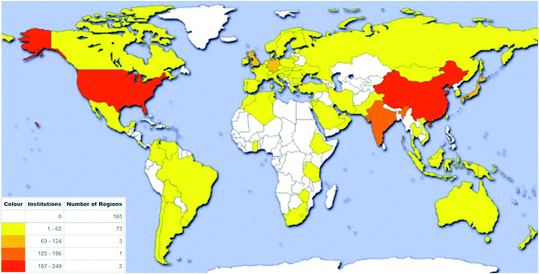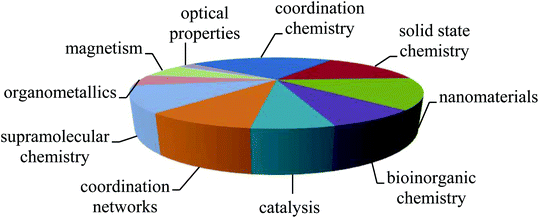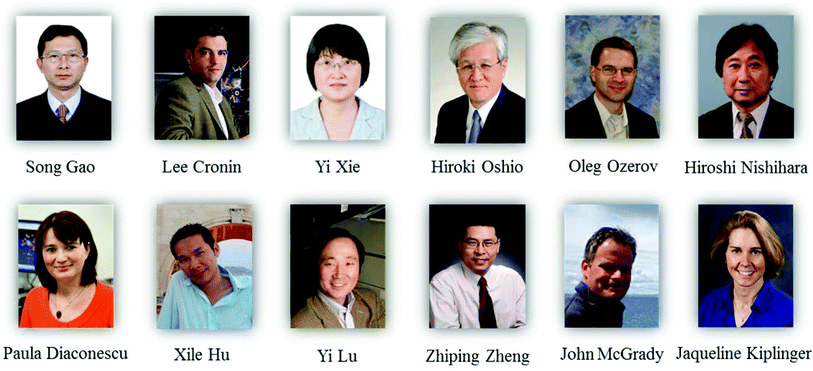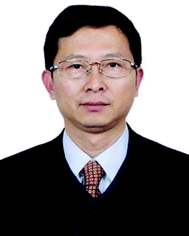Inorganic Chemistry Frontiers: home for cutting-edge research
Song Gao
Scientific content
Since the inaugural issue, Inorganic Chemistry Frontiers has received submissions from 17 countries. Top countries by contribution include China, Germany, India, the US and UK. Research published by the journal spans over 10 main categories of core inorganic chemistry as well as interdisciplinary fields between inorganic chemistry and nanoscience, materials, energy, biology etc. The topic coverage is reflected in the subject breakdown of articles that we have accepted in 2014 (Fig. 1).This year we are running two themed collections on the topics of “Crystal Engineering for Molecular Materials” and “Molecular Magnetism” to increase the journal's presence in the frontier research in inorganic materials and the under-represented area of magnetism. In 2015 Inorganic Chemistry Frontiers will continue to have themed collections on various timely topics, in addition to an “Emerging investigator” themed issue which aims to feature outstanding scientists at the early stages of their independent careers.
Inorganic Chemistry Frontiers publishes high quality review articles on key topics from leading chemists. Reviews published in 2014 include Liquid phase stepwise growth of surface mounted metal–organic frameworks for exploratory research and development of applications (DOI: 10.1039/C4QI00037D) by Roland Fischer et al. and Routes to tin chalcogenide materials as thin films or nanoparticles: a potentially important class of semiconductor for sustainable solar energy conversion (DOI: 10.1039/C4QI00059E) by Paul O'Brien et al. The top 10 most-cited research articles from the 2014 volume of Inorganic Chemistry Frontiers are highlighted in Table 1. We hope you will be impressed by their high quality and diversity of subjects, and agree with us that the first volume of the journal well reflects our objective of being an international journal for the best research from across inorganic chemistry.
| Title | Authors | DOI |
|---|---|---|
| Bi- and tri-dentate imino-based iron and cobalt pre-catalysts for ethylene oligo-/polymerization | Jing Ma, Chun Feng, Shaoli Wang, Ke-Qing Zhao, Wen-Hua Sun, Carl Redshaw and Gregory A. Solan | 10.1039/C3QI00028A |
| [NH2NH3][M(HCOO)3] (M = Mn2+, Zn2+, Co2+ and Mg2+): structural phase transitions, prominent dielectric anomalies and negative thermal expansion, and magnetic ordering | Sa Chen, Ran Shang, Ke-Li Hu, Zhe-Ming Wang and Song Gao | 10.1039/C3QI00034F |
| Design and synthesis of nucleobase-incorporated metal–organic materials | Muwei Zhang, Weigang Lu, Jian-Rong Li, Mathieu Bosch, Ying-Pin Chen, Tian-Fu Liu, Yangyang Liu and Hong-Cai Zhou | 10.1039/C3QI00042G |
| Room-temperature ABX3-typed molecular ferroelectric: [C5H9–NH3][CdCl3] | Yi Zhang, Heng-Yun Ye, Wen Zhang and Ren-Gen Xiong | 10.1039/C3QI00058C |
| N-heterocyclic silylene complexes in catalysis: new frontiers in an emerging field | Burgert Blom, Daniel Gallego and Matthias Driess | 10.1039/C3QI00079F |
| Self-assembly and structural transformations of high-nuclearity palladium-rich polyoxometalates | Jamie M. Cameron, Jing Gao, De-Liang Long and Leroy Cronin | 10.1039/C3QI00075C |
| Spin canting and metamagnetism in 3D pillared-layer homospin cobalt(II) molecular magnetic materials constructed via a mixed ligands approach | Ji-Yong Zou, Wei Shi, Hong-Ling Gao, Jian-Zhong Cui and Peng Cheng | 10.1039/C3QI00045A |
| Metal phosphonate hybrid materials: from densely layered to hierarchically nanoporous structures | Yun-Pei Zhu, Tian-Yi Ma, Ya-Lu Liu, Tie-Zhen Ren and Zhong-Yong Yuan | 10.1039/C4QI00011K |
| Sandwich-like carbon-anchored ultrathin TiO2 nanosheets realizing ultrafast lithium storage | Yongfu Sun, Jinbao Zhu, Liangfei Bai, Qiuyang Li, Xing Zhang, Wei Tong and Yi Xie | 10.1039/C3QI00050H |
| Integration of accessible secondary metal sites into MOFs for H2S removal | Georg Nickerl, Matthias Leistner, Stella Helten, Volodymyr Bon, Irena Senkovska and Stefan Kaskel | 10.1039/C3QI00093A |
To find out more about the latest Hot articles, most accessed articles, themed issues, etc., please sign up to the journal newsletter at http://rsc.li/alerts. All 2014 and 2015 content of the journal is freely available to every reader, ensuring the highest possible visibility for your publications. Taking advantage of the free access to the first two volumes, we invite you to submit your best work to Inorganic Chemistry Frontiers in 2015 at http://rsc.li/frontiers-inorganic.
Global visibility
Maximizing global visibility is always one of the top priorities of Inorganic Chemistry Frontiers. To date, users from more than 1500 institutions across 79 countries have accessed Inorganic Chemistry Frontiers. The geographic distribution of the institutes is shown in Fig. 2. | ||
| Fig. 2 Geographic distribution of the institutes that accessed Inorganic Chemistry Frontiers in 2014. | ||
As part of the global chemistry community, Inorganic Chemistry Frontiers had substantial presence at many key conferences in 2014, such as the ACS national meetings, the 29th CCS national meeting and the 41st International Conference on Coordination Chemistry. The Inorganic Chemistry Frontiers team and Editorial Board members will be attending a number of international conferences to follow the latest developments of the field, and to meet with our authors and readers in the coming year (Fig. 3).
February 2014 heralded the launch of the 1stInorganic Chemistry Frontiers International Symposium held in the College of Chemistry and Chemical Engineering, Peking University. Leading Chinese scientists along with our exceptional Editorial Board members delivered 11 informative talks covering the main significant research trends in inorganic chemistry. Feedback was received from the attendees with praise and recognition. This series of symposia will be held every 1–2 years in various countries.
If you are interested in our future activities or would like to meet with us at a 2015 conference, please stay up to date with the latest journal news via our blog (http://blogs.rsc.org/qi), Twitter (@inorgchemfront) and WeChat (inorgchemfront).
Collaboration with the Chinese chemistry community
In 2013, the CCS and the Royal Society of Chemistry announced the launch of the ‘Frontiers’ journal portfolio, a collection of chemistry journals combining high quality content and fast publication times with the trusted values of society publishing. An integral part of the development of each journal is the collaboration with an internationally regarded Chinese institute in the relevant field. For Inorganic Chemistry Frontiers, this is Peking University. Each Frontiers journal is jointly owned by the CCS, the Royal Society of Chemistry and the relevant partner institute, with each owner bringing their expertise to the project. Ultimately, the aim of the Frontiers portfolio is to become a leading international journal series for the chemistry community.This unique not-for-profit partnership between the CCS and the Royal Society of Chemistry celebrates a new phase in scientific growth. China is now ranked among the top countries in the world in chemistry research. In the past 10 years, the total number of chemistry papers from China as indexed by the Web of Science has been increasing by more than 10% every year. A study in 2014 by Thomson Reuters on highly cited researchers found that among 198 recorded chemical scientists, 30 are from China, putting the country second after the United States. In the Royal Society of Chemistry journals, around one third of the published articles are from Chinese scientists. The first volume of Inorganic Chemistry Frontiers distilled the best research from outstanding Chinese researchers, which made up more than 40% of the published content. We believe that Inorganic Chemistry Frontiers, as well as the whole Frontiers journal collection, will strongly benefit from the expanding influence of the Chinese chemistry community, providing researchers with unparalleled opportunities for global visibility and international collaboration.
A bright start to 2015
We are pleased to see this great selection of papers from internationally respected scientists for the inaugural issue of 2015. Inorganic Chemistry Frontiers will remain committed to the mission of promoting inorganic research, broadly defined and deemed significant. We would like to thank our Editorial Board members for their effort on successfully ensuring the high quality of publications. We do not forget the overwhelming support from our authors and referees, and hope you will continue to support us in the new year. Finally, please start reading your 2015 volume from here. We believe you will enjoy it.
(Editor-in-Chief)
| This journal is © the Partner Organisations 2015 |



